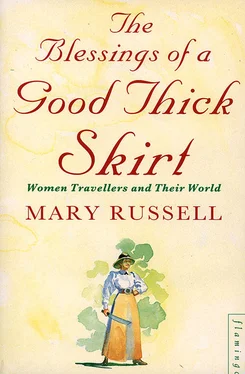Although Lilian Bland threw it all up for love, there were countless other young women following her who took to the air with equal joy and alacrity. In 1909, Madame la Baronne de Laroche of France was the first woman ever to gain a pilot’s licence. Three years later, on the day following the shattering loss of the Titanic, a young American journalist, Harriet Quimby, flew solo across the English Channel, taking less than an hour to do so.
In the States, during the recession, many young people – mostly men – found they could earn a living wing-walking and performing other aerial stunts. For a tired and dispirited populace, these dangerous exploits provided some sort of relief, the contemplation of others in danger somehow lessening the boredom and misery of their own dull or inactive lives. For women fliers, the practice served another, useful purpose. Generally thought not to be such good fliers as their male counterparts, anything which offered them a chance to display their skills could not be ignored. For one woman, at least, the strategy paid off. Phoebe Omlie, a talented and daring wing-walker, became the first person in the States to get a transport licence. For the spirited woman who liked excitement and adventure, flying provided an opportunity for both and once she had access to a plane, she could attain a freedom in the skies not available to her on the ground at all.
By the mid-1920s, however, state bureaucracy had begun to assert itself – almost always a bad omen for women. In 1924, the International Commission for Civil Aviation resolved that ‘women shall be excluded from any employment in the operative crew of aircraft engaged in public transport’. Another resolution stated categorically that candidates for such posts ‘must have use of all four limbs, be free from hernia and must be of the male sex’. Although these restrictions were later removed, the attitudes which prompted them were not. Some twenty years later, Jacqueline Cochrane, the first woman to break the sound barrier, was ‘allowed’ to deliver a bomber to England, as part of the war effort, provided that the take-off and landing were done by a male pilot.
Well aware of the problems faced by women in the field of aviation, Stella Wolfe, a journalist specializing in flying in the 1920s, made some points about the suitability of women which might now make us smile but which obviously needed stating then. Women, she said, were eminently suited to flying because they were lighter in weight and could endure cold better than men. Nor did they drink or smoke as much as men. Further, she believed that women, when able properly to sublimate their sex instincts, could use their maternal powers as a driving force in other fields. ‘Deprived of the right of motherhood and doomed to enforced celibacy by the ravages of war … she can put all that marvellous creative power, that tremendous endurance that enables the mother to undergo the agony of childbirth’ into flying. It was unfortunate that she should then have cited Lady Bailey as an example of a woman who had raised a large family and still had energy left for other activities. The privileged Lady Bailey only had surplus energy because she could afford to pay other women to look after her family and home. The Wolfe argument is not one that would appeal to the more independent-minded women of today but it was representative of the feminist thinking of the 1920s.
It was not until a few years later, in the early 1930s, that the public got the full benefit of America’s bright star: Amelia Earhart, that stalwart flier whose views on women and their place in society were as clear and determined as her own attitude to flying. ‘Unfortunately,’ she wrote, ‘I was born at a time when girls were still girls.’
Amelia Earhart was brought up in the early years of the century, in a large, pleasant clapboard house in Kansas. Her childhood years were happy and carefree although she learned early on that certain activities were considered ‘rough’ for a girl. Her father, an amiable man whose weakness for drink eventually led to the break-up of his marriage, made a living as a poorly paid lawyer on the railroad. Any extras the family might need were provided by Amelia’s maternal grandfather, who was a judge. Life for the small girl was unruffled and unexciting and there was nothing in her formal education nor in the girls’ literature of the day to stimulate a spirit of adventure. ‘… who ever heard of a girl – a pleasant one – skipping on an oil tanker, say, finding the crew about to mutiny and saving the captain’s life while quelling the mutiny? No, goings on of this sort are left to the masculine characters …’
If there was to be any excitement in her own life then clearly she herself would have to generate it. She enrolled as a medical student in New York but threw this up after a year. Unsettled, she moved to live with her parents in Los Angeles, then the centre of America’s aircraft industry. Soon, she had found the activity that was to dominate her whole life – flying. She took a job with a telephone company to pay for her flying lessons and with financial help from her mother, the judge’s daughter, she bought a second-hand plane. By 1922, at the age of twenty-four, she not only had her pilot’s licence but had also set a women’s altitude record for 14,000 feet. When her parents’ marriage finally broke up she drifted back across the States and took a job working with deprived children. Her life still had no clear direction. What was she, people asked, a social worker or a woman pilot?
‘Personally, I am a social worker who flies for sport,’ she tried to explain. ‘I cannot claim to be a feminist but do rather enjoy seeing women tackling all kinds of new problems, new for them, that is.’
Then, in 1928, everything fell into place. Could she, someone asked, take part in a flight across the Atlantic? She wouldn’t have to fly or anything, just simply be a passenger. The backer, a woman, was financing the flight in order to cement the friendship between America and England and wouldn’t it be nice, she said, to have a woman on the plane? Amelia was now thirty and had been drifting for too long. She accepted with alacrity. When a great adventure is offered, she said, you don’t refuse. But on this first Atlantic crossing Amelia was merely the token female taken along because the woman sponsor thought it a good idea. Not everyone shared that point of view. Commenting on the landing at Burryport in Wales, a Flight editorial said: ‘… in these days of sex equality such a feat should not arouse any particular comment Compared with the solo flights of such lady pilots as Lady Heath and Lady Bailey, the crossing as a passenger does not appear to us to prove anything in particular.’ Such a comment, ungainly as it was, had some justification and Amelia herself felt her presence had added little to aviation history: ‘All I did was to sit on the floor of the fuselage like a sack of potatoes.’
To add insult to injury, when the sponsorship money was being handed out, the pilot received $20,000, the mechanic received $5000 and she got nothing. Already an accomplished flier, it must have infuriated her to realize she had allowed herself to be used, and the experience spurred her on to reclaim what she felt she had lost ‘Some day,’ she said, ‘I will redeem my self-respect. I can’t live without it.’
She travelled round the country campaigning on behalf of women pilots but in the midst of it all took a surprising step. Marriage had never appealed to her and in any case, as she remarked to her sister, having babies took up too much time. She had had a suitor, however, for a number of years. George Putnam, the publisher, had been involved in her first transatlantic flight and found himself attracted by the slight, serious young woman with her open, gamine face and gap-toothed smile. He himself was married but on his divorce offered himself to Amelia. She refused over and over again and then, to his surprise, in the middle of her feminist campaign, she agreed to marry him.
Читать дальше












